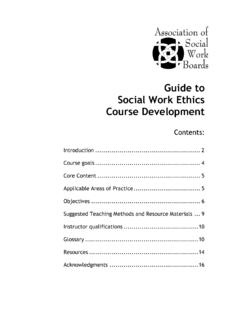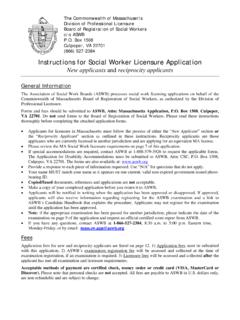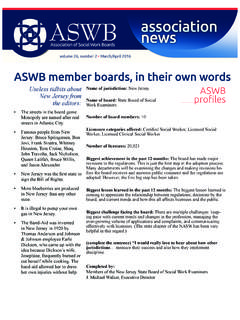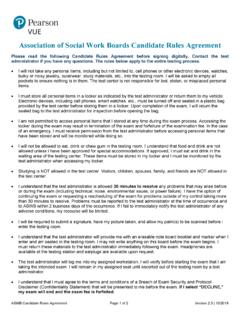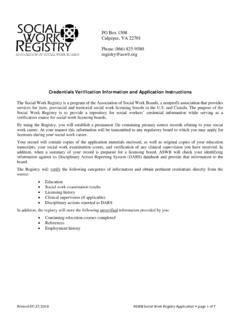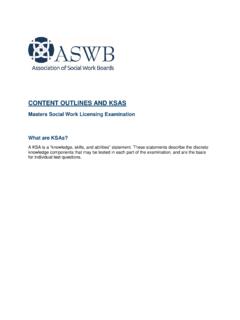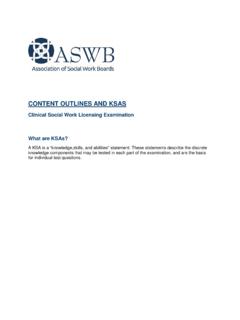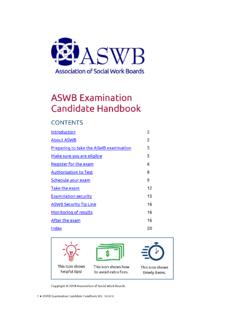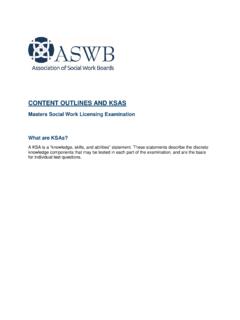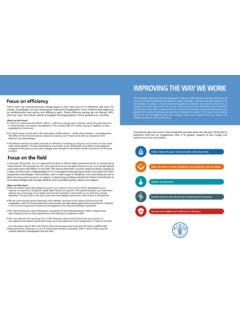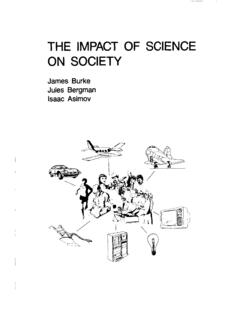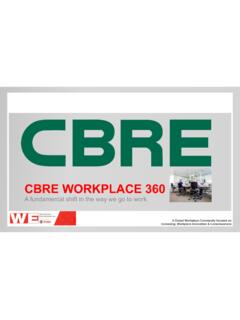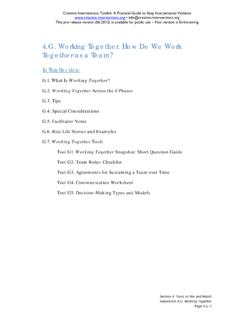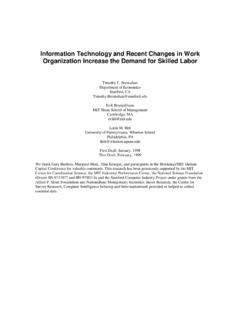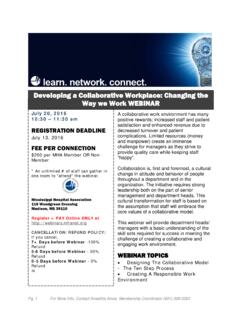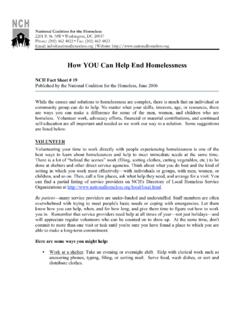Transcription of WE’RE ON OUR WAY Social Work Practice Mobility
1 WE RE ON OUR WAYS ocial work Practice MobilityReport of the proceedings of the ASWB Education Conference April 30 - May 2, 2015 2015, Association of Social work BoardsWhen ASWB s Board of Directors chose Social work Practice Mobility as a theme for the 2015 Spring Education Conference, the Board knew that it was setting the stage for a deep dive into a topic that has challenged our profession for is a complex topic, and developing a plan will be hard work ; but it will be something that ASWB members can do that will enhance public protection and the profession for many years to come. We want to create our own destiny and our own that end, the Board tasked the Regulatory Education and Leadership (REAL) Committee to develop an educational conference that would begin this important conversation. Over two days in May, more than 100 attendees from 44 states and provinces as well as international guests gathered to take part in a program designed to help them learn about our profession s readiness for Mobility and the efforts of other health care professions to develop Mobility models.
2 At the end of the second day, participants took part in a Strategic World Caf , where we began the process of synthesizing the information we had learned and engaging in creative thinking about how to achieve Mobility in our purpose of this report is to summarize the presentations made during the conference, identify the key findings, and share the artwork of the graphic recorder who captured many of the sessions visually as the audience listened and participated. In addition, resources about Mobility and links to websites of the presenters are included. Analyses of many of the Jurisdictional Mobility Assessment (JMA) survey responses can be found at We hope to stimulate your thinking as we embark on this journey are many ways to experience this report. Browse through the sessions and the artwork. Spend time reading about each session and studying the graphic recordings to gain deeper insight.
3 Skip to the end to read about the next steps that are planned. Explore the content offered through the hyperlinks. There is much to learn about Mobility , and we have taken advantage of technology to create a report that will expand your knowledge beyond the limits of the written word on a piece of paper. Enjoy and be enlightened!ASWB CEO Mary Jo Monahan, MSW, LCSWASWB Board President Dorinda N. Noble, , LCSWS ocial work Practice Mobility : Setting the AgendaAbout the artworkThroughout this report, you ll see full-page illustrations documenting some of the content. These illustrations are graphic recordings of the proceedings of the conference, drawn by graphic artist Nitya Wakhlu has a bachelor s degree in engineering and an MBA focused on human resources and organization development. Nitya is best known for her work as a graphic recorder and is privileged to have worked with corporate, government, and nonprofit groups across North America, Africa, India, and 2In this digital era, technology offers many benefits to clients convenience, affordability, access.
4 But technology also creates challenges: Social workers must be vigilant to maintain privacy, confidentiality, and work boundaries as well as other boundaries in the client-professional relationship. These were just a few of the issues keynote speaker Frederic Reamer discussed in his presentation Social work in a digital age: ethical and risk management challenges as he set the stage for this year s Spring Education Meeting on Social work Practice , ethics expert and well-known Social work educator, demonstrated how technology is transforming the nature of Social work Practice and raised awareness of the implications for states and provinces as their boards and colleges consider how to regulate technology-assisted Practice , which includes telephone and video counseling, synchronous online chat, and therapy via email and Facebook, to name a few.
5 All pose challenges for regulators, because therapy conducted using technology crosses state, provincial, and even international boundaries, depending on where the practitioner and the client are located. His first example was of a very recent treatment methodology, text therapy, in which a client gets help only through text messaging. According to the website, which offers the service, it s therapy for how we live today affordable, confidential, and anonymous. For attendees at the Spring Education Meeting mostly regulators representing the public protection interests of their states or provinces it s therapy that raises almost universal concern. As Reamer explained, therapy conducted entirely by text messaging leaves out an important piece of the therapy relationship: the meeting and connecting. The second example was of avatar-assisted therapy, in which clients and Social worker create anonymous electronic images to represent themselves in a real-time online therapy session.
6 Selecting a website from an extensive list of urls, Reamer clicked on a video in which clients and staff discussed the benefits of this type of treatment, including: convenience; overcoming barriers to traditional treatment, such as physical distance, lack of transportation, or disability; immersion in a non-threatening environment that encourages openness; and accessibility to resources. When surveyed, about half of the attendees indicated acceptance of the avatar-assisted treatment modality compared to the text messaging option. But an equal number raised their hands when asked if they had concerns about the regulatory the high degree of concern, few members of the audience indicated that their boards had discussed these issues. Yet as technology-assisted Practice continues to gain acceptance, options proliferate, demonstrating how technology is one of the great driving forces behind the need for regulation that embraces Practice Mobility and licensure put today s Practice methodologies in perspective, Reamer outlined five major periods of Social work history, explaining how the profession moved out of its roots in morality to develop its code of ethics and mission of helping everyone, with particular emphasis on people who are vulnerable, oppressed, and living in poverty.
7 Morality period (late 19th to early 20th century): with regard to ethics, the focus was on taking care of the pauper, drinker; characterized by judgmental language Values period (up through the 1970s): worldwide, Social work literature did not include language about ethics; focus was on the core values of the profession; for example, personal values vs. client values Ethical dilemmas & decision making (late 1970s through present): a sea change occurred in the 1980s, with the development of applied and professional ethics. Professionals (primarily in medicine) recognized that practitioners were facing extraordinarily difficult ethical decisions with regard to issues such as genetic engineering, selection of transplant recipients, and termination of life decisions. Schools began teaching ethics in the 1980s. The focus was on how Social workers made ethical judgments Social work in a digital world: Ethical and risk management challengesRegulating e- Practice .
8 The challenge definedGeneral Session Elements of Mobility 3 Ethics risk management (early 1990s to present): notable for a spike in litigation against Social workers for allegedly causing harm to clients; during this time the NASW Code of Ethics was developed as well as risk management tools, policies, etc. The focus was on how to manage risk in order to prevent it Digital era (mid-2000s to present): as the use of technology proliferates, Social workers face difficult intellectual dilemmas and moral dilemmas: What is meant by relationship in a digital age, when a personal interaction is not necessary? The focus is on how to serve clients, particularly the vulnerable and oppressed or impoverished who may not be able to pay for the technology by which services are offered There is quite a mix of ways in which Social workers are using technology to assist clients, Reamer said.
9 Many of these are reasonable, appropriate, ethical uses of technology to help people who are struggling. The Veterans Administration is on the cutting edge of much of this, Reamer noted. But there are ways that technology is misused, such as when privacy is breached through a Google search or when an untrained person presents himself or herself on a mental health website as a counselor. More troubling examples were given of two Social workers, both now incarcerated. One, who was working as a probation officer handling a caseload of sex offenders, was convicted on receiving child pornography via the Internet. The second Social worker, who was providing clinical services to clients in Michigan suffering traumatic brain injuries, was convicted of multiple sexual offenses against these female clients, one of whom he persuaded by visiting Christian websites with her as part of the deception.
10 To Reamer, technology is like a baseball bat, which can be a thing of beauty when used appropriately and a horrible weapon when used to cause harm. Some of it I find extraordinarily appealing, Reamer said of technology, and some of it really scares me. Issues surrounding the use of technology also exist outside the Practice realm, Reamer continued. Practitioners and agencies need to be mindful of how documents and records are managed now that recordkeeping in the cloud is becoming more prevalent. Electronic records stored this way cannot be destroyed. Email records and forensic computer audits comprise evidence presented in court at trial or before regulatory bodies in disciplinary hearings against Social workers accused of improper or illegal conduct, such as in the example of the incarcerated Michigan Social worker. Practitioners and regulators alike will have to develop solutions to these issues, because as Reamer said: The digital egg has cracked.
